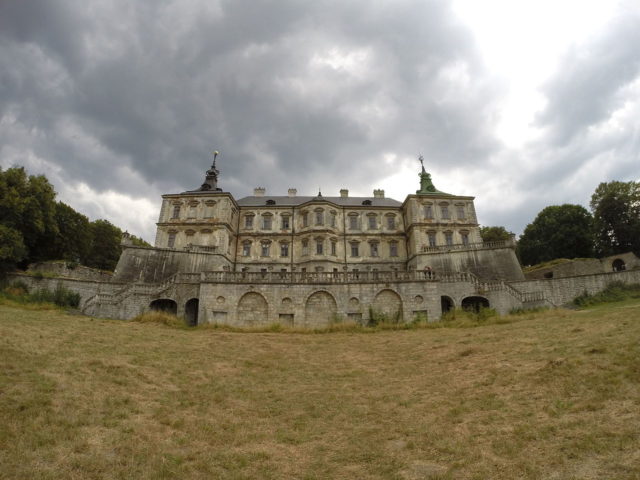Castles aren’t merely the cinematic majesty of history based films; the only appropriate and most effective defense mechanism of the antiquity that humanity has left is a whole treasure of gigantic and mesmerizing structures standing tall all over the civilized world.
One such castle now seems abandoned in Ukraine, and gives an eerie impression, but it once housed the royals of Poland and served as the symbol of monarchy in the region.
The Pidhirtsi Castle in the eastern borderland is technically a castle-fortress and is precisely located in the Pidhirtsi village in the western Ukrainian village of Lviv Oblast.


Seen from a long distance located on the northern side of Woroniaki hills, the structure is primarily built using bricks and stones and the design is in the characteristic Palazzo in fortezza style. The castle is almost 400 meters above sea level and is overlooking the famous Styr River valley. The height and precise location of the castle make it visible from larger distances, a chief characteristic of any castle.
However, Pidhirtsi castle had much more to offer and contribute to history aside from providing mere defense against intruders. The actual palace inside the castle is built into the hill slope. At its prime, the castle in the 17th century was surrounded by numerous vineyards and Italian Parterre gardens.
The wine produced by the many vineyards of the Pidhirtsi castle can be found celebrated in the poetry by Jakub Sobieski and also in the writings of Andrzej Morsztyn.
The castle is guarded by a moat and a drawbridge, the walls are fortified with iron cannons and bastions; some of the iron cannons are preserved to this day.


The castle was practically split into two ranges; the western part of the castle officially served as the residency for visitors and guests, whereas the eastern range was mostly private, reserved for the residences of the owners and servants of the castle.
Right above the entrance gate there is marble plaque that bears an inscription in Latin that talks about how the highest crown of any military labor has to be the victory, that victory is in fact triumph and that triumph in its truest sense is the ultimate rest.
In it’s prime time the Pidhirtsi castle also contained a private zoo with a number of exotic animals from around the world, a grange, a vineyard, a trout pond, an apiary and a mill.

Arguably the heyday of the castle is considered the time when it was under the ownership of Jakub Ludwick Sobieski.

During that time the castle was completely furnished and richly decorated with a number of halls and a large library, surrounded by beautiful parks and gardens blossoming with all kinds of plants and flowers.

Right next to the main entrance there used to be a Guardroom almost adjacent to the famous Knight room which housed hussar equipment and all kinds of modern weaponry. After that followed a suite of the Crimson Room, Mirror Room, Chinese Room, Yellow Room, and Green Room. In these rooms, a large collection of paintings by the 18th-century painter Szymon Czechowicz was kept.
These rooms got their names from the color of a trim or from what was stored in them and their walls were adorned with wallpaper and at least two hundred paintings. A series of highly valuable marble tiles were used to make the floors of the rooms, and in each there was a fireplace made also out of marble.
Another interesting aspect of the furnishing was a large collection of war booty collected by Stanislaw Koniecpolski from the wars fought against Tatars and Turks; these include some of the finest Persian rugs and some Turkish Royal tents. The large library of the castle once contained the archive of the Rzewski and Koniecpolski families.
So far the historians have not successfully established who in fact had designed the complex, however, the speculations are that the architect of the structure was an Italian by the name of Andrea del Aqua who is also the designer of a nearby fortress for the bellicose Koniecpolski.
The castle did prove to be an amazing shelter from the powerful invading armies on multiple occasions. In 1648 a large Ukrainian Cossack army attacked the castle during the famous Khmelnitsky Uprising, however, the Cossacks sorely failed to capture any part of the complex, proving the solid fortification of the castle. The Cossacks, bitter by their first defeat, tried another time almost three years later only to retreat, defeated once more.
In a unique set of events, the grandson of the original designer and builder of the castle, Stanislaw Koniecpolski, decided to gift the castle along with all its surrounding estates to Jakub Ludwick Sobieski.
A few years later, Jakub Sobieski, upon his return from the campaign against the Ottomans at Kamieniec, hosted his parents, King Jan III and his wife Marie Casimire Louise in the castle; Marie was French and absolutely loved the castle.


One of the courtiers of King Jan III, Francois d’Aleyrac, wrote about the magnificence of the castle and his words have, to this day, been preserved; he had suggested that the Ukranian Pidhitrsi castle was undoubtedly the most beautiful and elegant out of all such buildings built in Poland. He also added that in other countries such castles are regarded as unique and exquisite.
